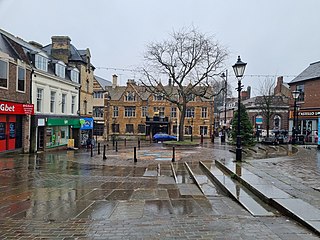
Wellingborough is a market town and civil parish in the North Northamptonshire unitary authority area of Northamptonshire, England. It is 65 miles (105 km) from London and 11 miles (18 km) from Northampton, and is on the north side of the River Nene.

Kettering is a market and industrial town as well as a civil parish in North Northamptonshire, England. It is 45 miles (72 km) west of Cambridge, 31 miles (50 km) southwest of Peterborough, 28 miles (45 km) southeast of Leicester and 15 miles (24 km) north-east of Northampton. It is west of the River Ise, a tributary of the River Nene. The name means "the place of Ketter's people ".

Irthlingborough is a town on the River Nene in North Northamptonshire, England. As of 2021, it has a population of 9,325, and was at one point the smallest town in England to have had a Football League team, Rushden & Diamonds F.C.. The parish church, St Peter, has a lantern tower, unusual for Northamptonshire churches, which was built to guide travellers across the Nene valley in foggy weather. It also has doors at the four cardinal points and has eight misericords in the chancel.

Burton Latimer is a town in North Northamptonshire, England, approximately 3.1 miles (5.0 km) southeast of Kettering and 4.5 miles north of Wellingborough. At the 2021 census, its population was 10,444.
Scaldwell is a village and civil parish in the West, Northamptonshire, England.
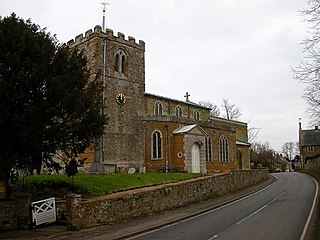
Lamport is a village and civil parish in West Northamptonshire, England. The village is on the A508, about 8 miles (13 km) south of Market Harborough and 8 miles (13 km) north of Northampton. Nearby is Lamport Hall. At the time of the 2001 census, the parish's population was 207 people, including Hanging Houghton and increasing to 225 at the 2011 Census.

Duston is a suburb of Northampton and a civil parish in West Northamptonshire, England.
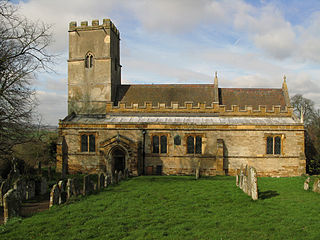
Stowe Nine Churches, also written as Stowe IX Churches, is a civil parish incorporating the settlements of Church Stowe and Upper Stowe in the West Northamptonshire district, in the ceremonial county of Northamptonshire, England. The population of the parish at the 2011 census was 259.

Blisworth is a village and civil parish in the West Northamptonshire, England. The West Coast Main Line, from London Euston to Manchester and Scotland, runs alongside the village partly hidden and partly on an embankment. The Grand Union Canal passes through the village and the north portal of the Blisworth tunnel is near Stoke Road.

Islip is a village and civil parish in North Northamptonshire, England. The village is just west of Thrapston and 7 miles (11 km) east of Kettering. The parish is bounded to the east by the River Nene and to the north by Harpurs Brook, a tributary of the Nene. The 2011 Census recorded the parish's population as 829 people.
Seend Ironstone Quarry and Road Cutting is a 3 acres (1.2 ha) Geological Site of Special Scientific Interest at Seend in Wiltshire, England, notified in 1965. The site contains facies of Lower Greensand containing specimens of fauna not found elsewhere.
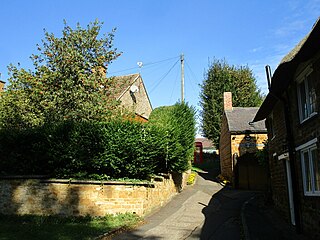
Thorpe Malsor is a village and civil parish 2 miles (3 km) west of Kettering, Northamptonshire, England. The population at the 2011 Census was 145.
The Kettering Ironstone Railway was an industrial 3 ft narrow gauge railway that served the ironstone quarries around Kettering.

Lowick is a village and civil parish forming part of the district of North Northamptonshire, England, about 2 miles (3.2 km) north-west of Thrapston. It appears in the Domesday Book of 1086 as Luhwik, and later as Lofwyk and in 1167 as Luffewich. The name derives from Old English "Luhha's or Luffa's dwelling place", wic being cognate to vicus in Latin. At the time of the 2011 census, the parish's population was 298 people.

Easton Neston is situated in south Northamptonshire, England. Though the village of Easton Neston which was inhabited until around 1500 is now gone, the parish retains the name. At the 2011 Census the population of the civil parish remained less than 100 and was included in the town of Towcester.

Wellingborough Loco Shed was a stabling point located in Wellingborough, Northamptonshire, England. The depot was situated on the Midland Main Line and was located just north of Wellingborough station.

Finedon Top Lodge Quarry, also known as Finedon Gullet is a 0.9-hectare (2.2-acre) geological Site of Special Scientific Interest east of Wellingborough in Northamptonshire. It is a Geological Conservation Review site revealing a sequence of middle Jurassic limestones, sandstones and ironstones, and is the type section for a sequence of sedimentary rocks known as the 'Wellingborough Member'. It was created by quarrying for the underlying ironstone for use at Wellingborough and Corby Steelworks; the ore was transported by the 1,000 mm gauge Wellingborough Tramway.
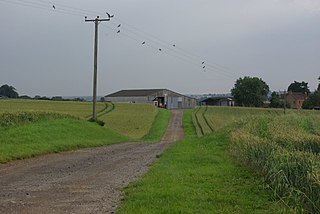
The Finedonhill Tramway was a British industrial narrow-gauge railway which operated under various ownership between 1875 and 1926.
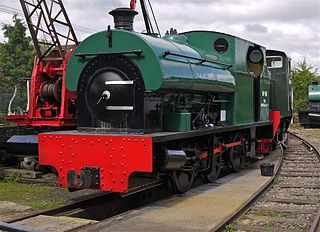
The Wellingborough Tramway was an industrial narrow-gauge railway that connected a series of ironstone mines and quarries with the Midland Railway and later with the ironworks on the north side of Wellingborough. In various forms, the tramway operated between 1875 and 1966.
Neilson's Tramway was a British industrial narrow-gauge railway which operated from 1881 to 1929.

























